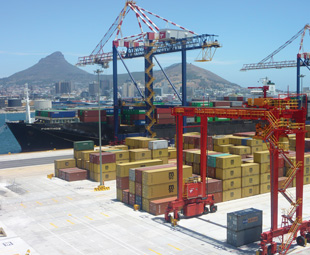Harbouring success

Humanity has been crossing oceans for millennia, initially in search of new lands and later for trade … it’s no wonder that transporting goods by sea freight still plays a major role in the global economy. JACO DE KLERK casts his net wide to reel in the lowdown of the effects of this form of transport and its related activities.
It is said that early human migration began when the pre-modern Homo erectus first migrated out of Africa over the Levantine corridor (a relatively narrow strip between the Mediterranean Sea to the northwest and an expanse of deserts to the southeast) and the Horn of Africa to Eurasia – about 1,8 million years ago.
As for the Americas … it is noted on HowStuffWorks – a site with nearly 40 million visitors each month – that, at the time, some icy conditions helped humanity’s migrating endeavours into this region.
“A massive sheet of ice, combined with lower sea levels, formed a bridge between Siberia and Alaska,” writes Ed Grabianowski, a contributing writer for HowStuffWorks, in his piece How Human Migration Works.
“There have long been competing theories that early humans crossed the Atlantic Ocean, from Africa to South America, or via the Caribbean, or from Europe to Greenland and then on to North America,” Grabianowski adds. “While it may have been possible to make such a trip using available seafaring technology, it is unlikely that a large-scale migration occurred in such a way.”
Nonetheless, sea travels have etched themselves into history with tales of the Vikings (who raided and traded from their Scandinavian homelands across wide areas of northern and central Europe), Christopher Columbus (whose voyages led to the first lasting European contact with the Americas) and Jan van Riebeeck (who established the initial Dutch settlement in the future South Africa).
These days, although it still plays a major role, exploration isn’t the main purpose of seafaring. “Even in our modern, speed-driven and globalised economy, 90 percent of everything still travels as it did almost 500 years ago,” writes Natasha Geiling on Smithsonian.com – which looks at topics and subject matters researched, studied and exhibited by the Smithsonian Institution (a group of 19 museums and galleries and nine research facilities administered by the United States government).
In her piece How the Shipping Industry is the Secret Force Driving the World Economy, Geiling speaks to Rose George – an author who spent several weeks aboard a container ship, sailing from England to Singapore, resulting in her book Ninety Percent of Everything.
“You’d be surprised at how many people think that everything comes by aeroplane, which it doesn’t because it’s so expensive,” George tells Geiling when discussing the public’s perception at large, during her interview. “Even a freight aeroplane can carry an absolute fraction of what a ship can carry.”
The shipping industry isn’t only a cog in the global economy because of its freight forwarding capabilities, however, as it also serves as a massive employer …
Rob Deane, general manager of Elgin Brown & Hamer South Africa (EBH SA), part of the DCD Marine Cluster (which includes EBH Namibia and DCD Marine Cape Town), notes that the shipbuilding and ship-repair industries, internationally, employ millions of people and thus have the capability to add substantially to a national economy. This is because of the forward and backward linkages associated with job creation, also known as the “multiplier effect”.
“It is not just about a shipyard creating jobs, it is the entire shipping industry supply chain that creates forward and backward linkages in relation to job creation,” explains Deane. “For example, if a growing shipyard requires more steel, the steel company will require more people, as will the steel mill and so on, all the way back to the mine.”
He adds that transport, fuel, electricity and administration will also all be impacted by growth and job creation. “The forward linkages relate to increased spend by employees on houses, fuel, electricity, water, and so on – which, in turn, generates income in those sectors.”
One example, within the DCD Marine Cluster itself, is EBH Namibia’s investment in infrastructure in Walvis Bay. “As long as there is sustainable growth, the knock-on effect is job creation, not only for employees, but for subcontractors and suppliers as well – the impact is felt down the line,” says Deane. “In Walvis Bay we are seeing this effect already. The whole town is benefiting as a result of the growing shipyard.”
This isn’t the only economy that has been influenced by the Cluster’s activities. The other example landed DCD Marine Cape Town and its client Saipem an award from the Western Cape provincial government in recognition for the recent work done on the Scarabeo 7 – a semi-submersible drilling rig.
“It is an honour to be recognised by the Western Cape government for the hard work and time that DCD Marine Cape Town has invested to ensure that we put Cape Town on the global map as a rig repair destination of choice,” says Gerry Klos, general manager of the company. “The award also recognises our valued client Saipem for the role it has played, by bringing in this significant project and thereby boosting the local economy.”
The Scarabeo 7 project consumed a total of 3,2-million man hours, brought in more than R1 billion in revenue to the province and created 1 193 jobs. It also provided downstream employment through the subcontractors assigned to the venture.
Alan Winde, Western Cape minister of economic opportunities, adds: “This project has delivered a massive boost to economic growth and job creation in the Western Cape. The DCD Marine shipyard is an important player in the province’s maritime industry and is attracting significant foreign investment, specifically in the rig repair industry, which is a key growth sector.”
He says that the oil and gas sector employs 8 500 people, of which 3 000 work in rig repair and maintenance. “We are grateful to both companies involved in this massive project for the role they have played in helping to build a sustainable local economy. The world-class service DCD Marine Cape Town offers makes it an asset to the Western Cape.”
Jan van Riebeeck would be proud …
Published by
Focus on Transport
focusmagsa




